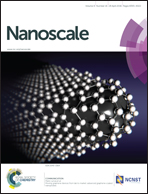Formation of palladium concave nanocrystals via auto-catalytic tip overgrowth by interplay of reduction kinetics, concentration gradient and surface diffusion
Abstract
A clear understanding of the growth mechanism involved in the shape-controlled synthesis of noble-metal nanocrystals with concave surfaces can provide useful information for the rational design of novel anisotropic nanostructures with controllable properties. In this paper, we conducted a systematic study of the detailed growth mechanism of the Pd arrow-headed tripods and revealed how the formation of the concave Pd nanocrystals was collectively controlled by the reduction kinetics, concentration gradient of Pd precursors, and surface diffusion of atoms. The formation of the arrow-headed tripods can be attributed to an auto-catalytic tip overgrowth process, where the Pd triangular nanoplate seeds formed under a suitably slow reduction rate can auto-catalyze the dehydrogenation of benzyl alcohol to generate hydrogen atoms [H]. The presence of [H] further dramatically accelerates the reduction of Pd(acac)2, which introduces a concentration gradient of Pd precursors in our non-stirring synthesis system and facilitates the kinetically-controlled tip overgrowth under a concentration gradient to form tripods with troughs on the arms. The final shapes of the concave nanocrystals depend on the relative rate of atom deposition and surface diffusion of atoms, which can be tuned by manipulating the reaction conditions such as the reaction temperature and the stirring conditions. This study presents a new possibility for the rational synthesis of various Pd nanostructures by manipulating the auto-catalytic process and tuning the relative rate of atom deposition and surface diffusion of atoms, which provides useful information for understanding the growth mechanism and the design of other anisotropic noble-metal nanostructures.


 Please wait while we load your content...
Please wait while we load your content...